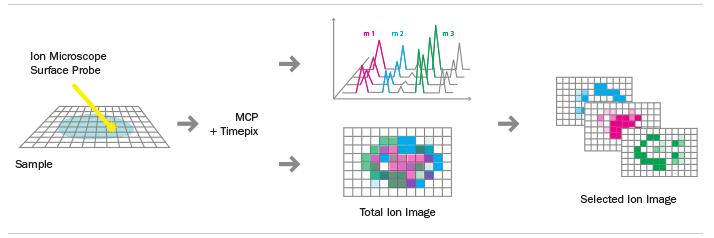In high-throughput time-of-flight mass spectrometric imaging (TOF-MSI), the pressure is on the detection system: it must measure the impact position and time of the entire ion load from an ionization event in a single measurement frame. Now, using an innovative electron and ion imaging camera, this can be achieved. The approach combines a chevron microchannel plate (MCP) stack with an active pixel detector chip. Ion mass microscopy is a molecular imaging technique that delivers analyte identity and spatial localization with very high throughput at sub-micron pixel sizes. A large-area desorption/ionization beam illuminates the sample surface; ion optics magnify the molecular images and retain the spatial information; and the molecular ion distributions are mapped on a position-sensitive detector.

The new detection system is based on application-specific integrated circuits (ASIC) developed by the Medipix collaboration hosted by CERN, Geneva, Switzerland. The Timepix chips comprise tens of thousands of pixels each with a pitch of 55 µm, all of which function as individual units for parallel detection. Importantly, the Timepix chips provide spatial event information (via the pixel address) as well as time-of-flight, particle energy and event counting at the pixel level.
The new camera has been successfully tested on benchmark systems (protein and lipid standards) and with biologically relevant macromolecular tissue samples (rat brain and testes). TOF-MSI systems offer several unique capabilities afforded by the combination of high signal-to-noise ratios, multiplexed detection of events by a highly parallel detection system, high sensitivity, dynamic range, large mass range and simultaneous detection of position- and time-information by a single detector. All of which means higher throughput for faster analysis, the ability to detect small quantities of analytes, and better spatial resolution, revealing unprecedented detail.
As TOF-MSI continues to mature, applications in diagnostics, medical imaging, fundamental atomic and molecular physics, and even space science are likely to grow.
For more information, visit www.amolf.nl/medipix.




